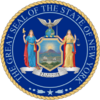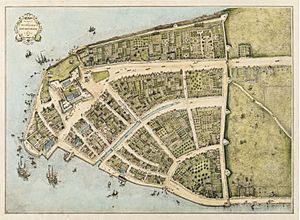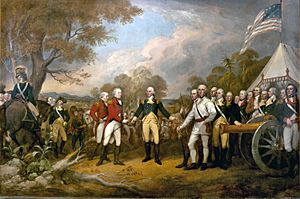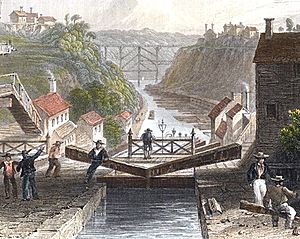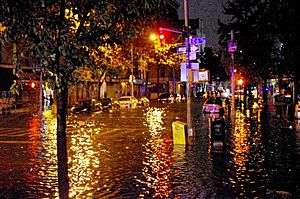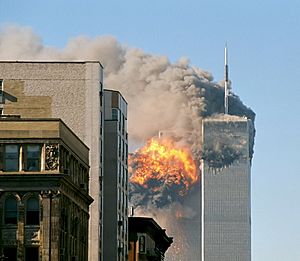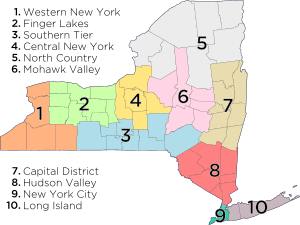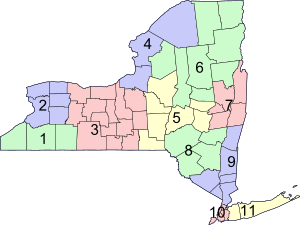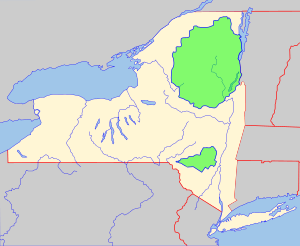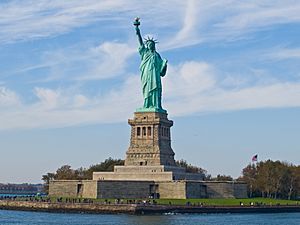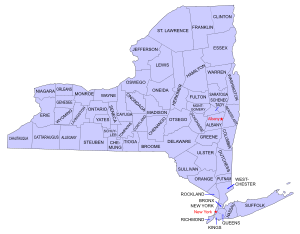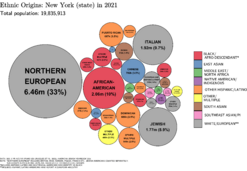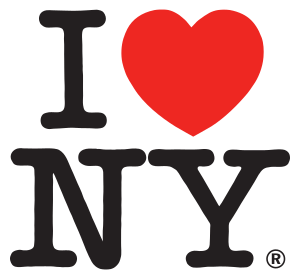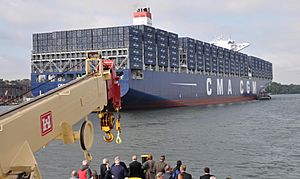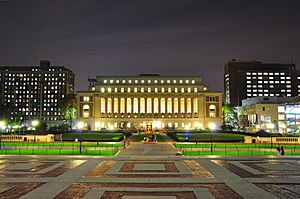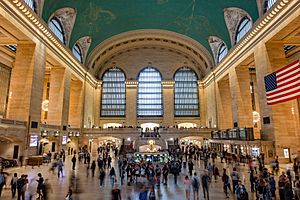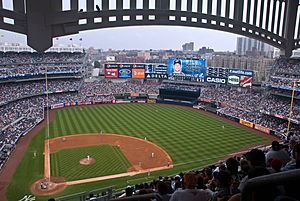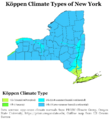New York (state) facts for kids
Quick facts for kids
New York
|
|||
|---|---|---|---|
| State of New York | |||
|
|||
| Nickname(s): | |||
| Motto(s):
Excelsior
Ever upward |
|||
| Anthem: "I Love New York" | |||
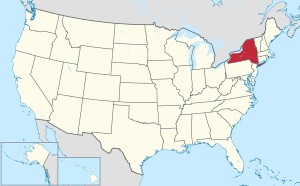
Location of New York within the United States
|
|||
| Country | United States | ||
| Before statehood | Province of New York | ||
| Admitted to the Union | July 26, 1788 (11th) | ||
| Capital | Albany | ||
| Largest city | New York | ||
| Largest county or equivalent | Kings (Brooklyn) | ||
| Largest metro and urban areas | New York metropolitan area | ||
| Legislature | State Legislature | ||
| • Upper house | State Senate | ||
| • Lower house | State Assembly | ||
| Judiciary | New York Court of Appeals | ||
| U.S. senators |
|
||
| U.S. House delegation |
|
||
| Area | |||
| • Total | 54,555 sq mi (141,298 km2) | ||
| • Land | 47,126 sq mi (122,057 km2) | ||
| • Water | 7,429 sq mi (19,240 km2) 13.6% | ||
| Area rank | 27th | ||
| Dimensions | |||
| • Length | 330 mi (530 km) | ||
| • Width | 285 mi (455 km) | ||
| Elevation | 1,000 ft (300 m) | ||
| Highest elevation | 5,344 ft (1,629 m) | ||
| Lowest elevation | 0 ft (0 m) | ||
| Population
(2023)
|
|||
| • Total | 19,571,216 | ||
| • Rank | 4th | ||
| • Density | 416.42/sq mi (159/km2) | ||
| • Density rank | 8th | ||
| • Median household income | $75,200 | ||
| • Income rank | 14th | ||
| Demonym(s) | New Yorker | ||
| Language | |||
| • Official language | None | ||
| • Spoken language | |||
| Time zone | UTC−5 (EST) | ||
| • Summer (DST) | UTC−4 (EDT) | ||
| USPS abbreviation |
NY
|
||
| ISO 3166 code | US-NY | ||
| Traditional abbreviation | N.Y. | ||
| Latitude | 40° 30′ N to 45° 1′ N | ||
| Longitude | 71° 51′ W to 79° 46′ W | ||
| Bird | Eastern bluebird |
|---|---|
| Fish | Brook trout (fresh water), Striped bass (salt water) |
| Flower | Rose |
| Fruit | Apple |
| Tree | Sugar maple, Lilac bush |
| Insect | Nine-spotted ladybug |
| Sport | Baseball |
New York, also known as New York State, is a large state in the Northeastern United States. It's one of the Mid-Atlantic states. New York shares borders with New Jersey, the Atlantic Ocean, New England, Canada, and the Great Lakes.
With nearly 19.6 million people, New York is the fourth-most populated state in the U.S. It's also the eighth-most crowded state as of 2023. New York is the 27th-largest U.S. state by area, covering about 141,298 square kilometers (54,556 square miles).
New York has a very different landscape. The southeastern part, called Downstate, includes New York City. This is the biggest city in the United States. It has more than twice the population of Los Angeles. This area also includes Long Island, the most populated island in the U.S. The lower Hudson Valley also has suburbs and wealthy towns. These areas are the heart of the New York metropolitan area and are home to about two-thirds of the state's people.
The much larger Upstate area stretches from the Great Lakes to Lake Champlain. It includes the Adirondack Mountains and the Catskill Mountains. These are part of the larger Appalachian Mountains. The Mohawk River Valley cuts through the mountains in Upstate New York. It flows into the Hudson River valley near Albany, the state capital. Western New York, where Buffalo and Rochester are, is part of the Great Lakes region. It borders Lake Ontario and Lake Erie. Central New York is centered around Syracuse. Between the central and western parts of the state, you'll find the Finger Lakes, a popular place for tourists. To the south, along the border with Pennsylvania, the Southern Tier sits on the Allegheny Plateau. This is the northern part of Appalachia.
New York was one of the original Thirteen Colonies that formed the United States. Before Europeans arrived, Native American tribes like the Algonquians and the Iroquois Confederacy lived here for thousands of years. In 1609, Henry Hudson explored the area. The Dutch then started the colony of New Netherland in 1621. England took over the colony in 1664 and renamed it the Province of New York.
During the American Revolutionary War, colonists fought for independence. New York became a state in 1788. In the early 1800s, New York built the Erie Canal. This gave the state a huge advantage over other parts of the U.S. The state grew in power, culture, and economy over the next century. This earned it the nickname "Empire State." Even though some industries declined in the late 1900s, New York is still a global leader in new ideas, business, and caring for the environment.
New York attracts many visitors from all over the world. In 2022, it had the most visitors of any U.S. state. Many famous places are here, like Times Square, Central Park, Niagara Falls, and Grand Central Terminal. New York has about 200 colleges and universities. These include Ivy League schools like Columbia University and Cornell University. The State University of New York is one of the largest university systems in the country. New York City is home to the headquarters of the United Nations. It is often called the world's most important city, a center for culture, finance, and media.
Contents
- History of New York State
- Geography of New York
- People of New York
- Economy of New York
- Education in New York
- Transportation in New York
- Sports in New York
- Images for kids
- See also
History of New York State
Native American History in New York
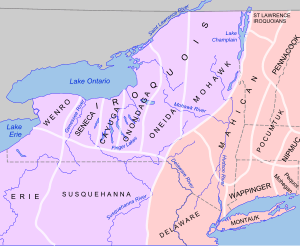
The main Native American tribes in what is now New York were the Iroquois and Algonquian peoples. Long Island was shared by the Algonquian Wampanoag and Lenape tribes. The Lenape also lived around New York Harbor. North of the Lenape were the Mohicans, another Algonquian group. Further north, from east to west, were two Iroquoian tribes: the Mohawk and the Petun. South of them, near the Appalachian mountains, were the Susquehannock and the Erie.
Some Wampanoag and Mohican people were involved in King Philip's War. This was a fight by many New England tribes to remove Europeans from their land. After their leader, Chief Philip, died, many of these people moved inland. They split into the Abenaki and the Schaghticoke tribes. Some Mohicans stayed in the region until the 1800s. A small group, the Ouabano, moved southwest and may have joined the Shawnee.
The Mohawk and Susquehannock tribes were very strong fighters. They tried to control trade with Europeans and attacked other tribes. The Mohawk also did not allow white settlers on their land. They also treated their own people badly if they became Christian. The Susquehannock briefly took over the Lenape lands in the 1600s. But the most important event of that time was the Beaver Wars.
From about 1640 to 1680, the Iroquois tribes fought many battles. These battles stretched from modern-day Michigan to Virginia. They fought against Algonquian and Siouan tribes, and even among themselves. Their goal was to control more land for animal trapping. Many Native Americans had started trapping to trade with Europeans. These wars completely changed the tribes in the region. Most large animals were hunted out before Europeans fully explored the land. After the wars, the Iroquois Confederacy offered safety to people from other tribes. These included the Mascouten, Erie, Chonnonton, Tutelo, Saponi, and Tuscarora nations. The Tuscarora became the sixth nation of the Iroquois.
In the 1700s, Iroquoian people welcomed the remaining Susquehannock from Pennsylvania. This happened after they were greatly weakened in the French and Indian War. Most of these groups joined the Iroquois and eventually lost their separate tribal identities. After the American Revolution, a large group of Seneca split off. They returned to Ohio and became known as the Mingo Seneca. Today, the Six Nations of the Iroquois Confederacy are the Seneca, Cayuga, Onondaga, Oneida, Tuscarora, and Mohawk. The Iroquois fought on both sides during the Revolutionary War. Many Iroquois who supported the British moved to Canada afterward. Today, the Iroquois still live in several areas across New York and Ontario.
Meanwhile, the Lenape became close with William Penn. But after Penn died, his sons took much of their land. They forced the Lenape to move to Ohio. When the U.S. passed the Indian Removal Act, the Lenape were moved again to Missouri. Their cousins, the Mohicans, were sent to Wisconsin.
In 1778, the United States moved the Nanticoke from the Delmarva Peninsula. They went to former Iroquois lands south of Lake Ontario. However, they did not stay long. Most chose to move to Canada and join the Iroquois. Some moved west and joined the Lenape.
Early European Exploration and Settlement
In 1524, Giovanni da Verrazzano, an Italian explorer working for the French crown, explored the Atlantic coast of North America. He visited New York Harbor and Narragansett Bay. On April 17, 1524, Verrazzano entered New York Bay. He went through the strait now called the Narrows into the northern bay. He named it Santa Margherita, after the King of France's sister. Verrazzano described it as "a huge coastline with a deep delta where all kinds of ships could pass." He added that "it goes inland for a league and opens up to form a beautiful lake." This large body of water was full of native boats. He landed on the tip of Manhattan and possibly on the farthest point of Long Island. A storm then pushed Verrazzano north toward Martha's Vineyard.
In 1540, French traders from New France built a chateau (a large country house) on Castle Island, near what is now Albany. They left it the next year because of flooding. In 1614, the Dutch, led by Hendrick Corstiaensen, rebuilt the French chateau. They called it Fort Nassau. Fort Nassau was the first Dutch settlement in North America. It was located along the Hudson River, also near present-day Albany. The small fort was a trading post and a warehouse. It was on the Hudson River flood plain, so it was washed away by floods in 1617. It was left for good after Fort Orange (New Netherland) was built nearby in 1623.
New Netherland and English Takeover
Henry Hudson's trip in 1609 was the start of European involvement in the area. He was sailing for the Dutch East India Company and looking for a way to Asia. He entered the Upper New York Bay on September 11 of that year. News of his discoveries encouraged Dutch merchants to explore the coast. They wanted to trade furs with the local Native American tribes.
During the 1600s, the Dutch set up trading posts in the colony of New Netherland. They traded animal furs with the Lenape, Iroquois, and other tribes. The first trading posts were Fort Nassau (1614, near Albany); Fort Orange (1624, south of Albany, replacing Fort Nassau), which grew into the settlement of Beverwijck (1647) and later Albany; Fort Amsterdam (1625), which became the town of New Amsterdam (present-day New York City); and Esopus (1653, now Kingston). The success of the patroonship of Rensselaerswyck (1630), which surrounded Albany, also helped the colony succeed early on.
The English captured the colony during the Second Anglo-Dutch War and called it the Province of New York. The city of New York was taken back by the Dutch in 1673 during the Third Anglo-Dutch War (1672–1674). They renamed it New Orange. It was given back to the English under the Treaty of Westminster a year later.
New York During the American Revolution
The Sons of Liberty group started in New York City in the 1760s. They were upset about the Stamp Act passed by the British Parliament in 1765. The Stamp Act Congress met in the city on October 19 of that year. Representatives from all Thirteen Colonies attended. This meeting set the stage for the later Continental Congress. The Stamp Act Congress created the Declaration of Rights and Grievances. This was the first time Americans wrote down their rights and complaints, including the right to representative government. However, many New Yorkers were Loyalists, meaning they supported the British, because of strong business and personal ties to Britain. The Capture of Fort Ticonderoga provided cannons and gunpowder. These were needed to force the British to leave the siege of Boston in 1775.
New York was the only colony that did not vote for independence at first. Its delegates were not allowed to. New York then supported the Declaration of Independence on July 9, 1776. The New York State Constitution was written by a meeting in White Plains on July 10, 1776. After many changes, it was finished in Kingston on April 20, 1777. The new constitution, written by John Jay, was approved with only one vote against it. It was not put to a public vote. On July 30, 1777, George Clinton became the first Governor of New York in Kingston.
About one-third of all battles in the American Revolutionary War happened in New York. The first big battle, and the largest of the whole war, was the Battle of Long Island (also called the Battle of Brooklyn) in August 1776. After winning, the British took over New York City. They used it as their main military and political base in North America for the rest of the war. This made it the focus of General George Washington's spy network. More American soldiers died on the terrible British prison ships in Wallabout Bay than in all battles of the war combined. Both sides lost more soldiers to disease than to battle wounds.
The first of two major British armies was captured by the Continental Army at the Battle of Saratoga in 1777. This victory convinced France to become an ally of the American revolutionaries. New York became the 11th state to approve the United States Constitution on July 26, 1788.
To keep their independence between the new United States and British North America, four of the Iroquois Nations fought with the British. Only the Oneida and Tuscarora sided with the Americans. In response to attacks on the frontier by Joseph Brant and Loyalist Mohawk forces, the Sullivan Expedition of 1779 destroyed almost 50 Iroquois villages. They also destroyed crops and winter supplies. This forced many people to flee to British-held Niagara.
As British allies, the Iroquois were forced out of New York. They were not part of the peace talks. They moved to Canada after the war and were given land by the British Crown. In the peace treaty, the British gave most Native American lands to the new United States. New York made a treaty with the Iroquois without Congress's approval. Because of this, some land purchases have been challenged in court by federally recognized tribes since the late 1900s. New York put more than 5 million acres (20,000 square kilometers) of former Iroquois land up for sale after the Revolutionary War. This led to fast growth in Upstate New York. As per the Treaty of Paris, the last British troops left New York City in 1783. This day was celebrated as Evacuation Day for a long time.
New York's Growth in the 1800s and 1900s
Before canals, travel in Western New York was slow and expensive. Wagons traveled on muddy roads. Governor DeWitt Clinton supported building the Erie Canal. This canal connected New York City to the Great Lakes using the Hudson River and the new canal. Work started in 1817, and the Erie Canal opened eight years later, in 1825. Boats pulled by horses on paths next to the canal carried people and goods slowly. Farm products came from the Midwest, and finished goods moved west. The canal was an amazing engineering feat. It opened up huge areas of New York for business and settlement. It helped Great Lakes cities like Buffalo and Rochester grow. It also connected the growing farms of the Midwest and shipping on the Great Lakes with the port of New York City. The canal improved transportation and helped more people move to areas west of New York. After 1850, railroads mostly took over from the canal.
The canal and later the railroads led to a huge economic boom across the state until the 1950s. Many big companies started in New York during this time. These include American Express, AT&T, Bristol Myers Squibb, Carrier, Chase, General Electric, Goldman Sachs, IBM, Kodak, Macy's, NBC, Pfizer, Random House, RCA, Tiffany & Co., Wells Fargo, Western Union, and Xerox.
New York City was a major ocean port. It imported cotton from the South and exported manufactured goods. Almost half of the state's exports were related to cotton. Southern cotton traders, farmers, and bankers visited so often that they had favorite hotels. At the same time, the movement to end slavery (abolitionism) was strong upstate. Some communities there were stops on the Underground Railroad. Upstate New York and New York City strongly supported the American Civil War. They provided money, volunteer soldiers, and supplies. The state sent over 370,000 soldiers to the Union armies. Over 53,000 New Yorkers died in service, which is about one out of every seven who served. However, Irish riots against the draft in 1862 were a big problem.
Immigration to New York
Since the early 1800s, New York City has been the biggest port of entry for legal immigrants coming to the United States. Before 1890, the federal government did not directly handle immigration. It was left to individual states. Most immigrants to New York arrived at the busy docks along the Hudson and East Rivers in Lower Manhattan. On May 4, 1847, the New York State Legislature created the Board of Commissioners of Immigration to manage immigration.
The first permanent immigration center in New York opened in 1855 at Castle Garden. This was a former fort from the War of 1812. It was located in what is now Battery Park, at the tip of Lower Manhattan. The first immigrants to arrive there were on three ships that had just finished quarantine. Castle Garden was New York's immigrant center until it closed on April 18, 1890. At that time, the federal government took over immigration. During this period, more than eight million immigrants passed through its doors. This was two out of every three U.S. immigrants.
When the federal government took control, it created the Bureau of Immigration. They chose the three-acre (1.2 hectare) Ellis Island in Upper New York Harbor as an entry point. The island was already controlled by the federal government and had been used to store ammunition. It was chosen because it was somewhat isolated but close to New York City. It was also near the rail lines of Jersey City, New Jersey, with a short ferry ride. While the island was being developed and made larger with land reclamation, the federal government used a temporary center at the Barge Office at the Battery.
Ellis Island opened on January 1, 1892. It served as a main immigration center until the National Origins Act was passed in 1924. This law reduced immigration. After that date, only displaced persons or war refugees passed through. The island stopped all immigration processing on November 12, 1954. The last person held there, Norwegian sailor Arne Peterssen, was released. He had stayed past his shore leave and left on the 10:15 a.m. ferry to Manhattan to return to his ship.
More than 12 million immigrants passed through Ellis Island between 1892 and 1954. Over 100 million Americans today can trace their family history to these immigrants. Ellis Island was part of a long argument between New York and New Jersey over who owned it. The issue was settled in 1998 by the U.S. Supreme Court. They ruled that the original 3.3-acre island was New York state territory. The rest of the 27.5 acres added after 1834 by landfill were in New Jersey. In May 1964, President Lyndon B. Johnson added Ellis Island to the National Park Service. It is still owned by the federal government as part of the Statue of Liberty National Monument. In 1990, Ellis Island opened to the public as a museum about immigration.
New York in the 21st Century
September 11 Attacks
On September 11, 2001, two hijacked planes crashed into the Twin Towers of the original World Trade Center in Lower Manhattan. Both towers collapsed. 7 World Trade Center also fell due to fire damage. Other buildings in the World Trade Center complex were too damaged to fix and were torn down. The collapse of the Twin Towers caused huge damage and killed 2,753 people. This included 147 people on the two planes. Since September 11, most of Lower Manhattan has been rebuilt. In the years since, over 7,000 rescue workers and people who lived in the area have developed serious illnesses, and some have died.
A memorial at the site, the National September 11 Memorial & Museum, opened to the public on September 11, 2011. A permanent museum opened there on March 21, 2014. When it was finished in 2014, the new One World Trade Center became the tallest skyscraper in the Western Hemisphere. It is 1,776 feet (541 meters) tall, symbolizing the year America gained independence, 1776. From 2006 to 2018, several other buildings were completed. These include 3 World Trade Center, 4 World Trade Center, 7 World Trade Center, the World Trade Center Transportation Hub, Liberty Park, and Fiterman Hall. St. Nicholas Greek Orthodox Church and the Ronald O. Perelman Performing Arts Center are still being built at the World Trade Center site.
Hurricane Sandy in 2012
On October 29 and 30, 2012, Hurricane Sandy caused a lot of damage to New York's coastlines. It hit parts of New York City, Long Island, and southern Westchester with record-high storm surge. This caused severe flooding and strong winds. Hundreds of thousands of New Yorkers lost power. There were also gasoline shortages and problems with mass transit systems. The storm and its effects have led to talks about building seawalls and other coastal barriers around New York City and Long Island. This would help protect against future storms, which are likely due to global warming and rising sea levels.
COVID-19 Pandemic (2020–2023)
On March 1, 2020, New York had its first confirmed case of COVID-19. This was two months after Washington state. By March 28, New York had the most confirmed cases of any state in the U.S. By February 1, 2021, other states had more cases. In March 2020, almost 50 percent of known national cases were in New York. One-third of all known U.S. cases were in New York City.
From May 19–20, Western New York and the Capital Region started Phase 1 of reopening. On May 26, the Hudson Valley began Phase 1. New York City partly reopened on June 8.
In July 2020, a federal judge ruled that Governor Andrew Cuomo and Mayor Bill de Blasio went too far. They had limited religious gatherings to 25% capacity, while other places could operate at 50%. On Thanksgiving Eve, the U.S. Supreme Court stopped more religious restrictions. These had been put in place by Cuomo for areas with many infections.
New York's government released a new seal, coat of arms, and flag in April 2020. They added "E pluribus unum" (meaning "Out of many, one") below the state's motto. A law using the new flag, arms, and seal went into effect in September.
Abolition Commemoration Day, also known as the Fifth of July, was brought back in the early 2000s. It celebrates the end of slavery in New York. In July 2020, the New York State Assembly passed a law officially recognizing Abolition Commemoration Day and Juneteenth in New York. Abolition Commemoration Day is on the second Monday in July, and Juneteenth is on June 19.
Geography of New York

The state of New York covers a total area of 141,298 square kilometers (54,555 square miles). It ranks as the 27th-largest state by size. The highest point in New York is Mount Marcy in the Adirondack High Peaks in Northern New York. It is 1,629 meters (5,344 feet) above sea level. The state's lowest point is at sea level, on the Atlantic Ocean in Downstate New York.
Unlike New York City's urban areas, most of the state is covered by meadows, forests, rivers, farms, mountains, and lakes. Most of the southern part of the state sits on the Allegheny Plateau. This plateau stretches from the southeastern United States to the Catskill Mountains. The part in New York State is called the Southern Tier. The rugged Adirondack Mountains, with large areas of wilderness, are west of the Lake Champlain Valley. The Great Appalachian Valley is a major feature in eastern New York. It includes the Lake Champlain Valley in the north and the Hudson Valley in the south. The Tug Hill region is a cuesta (a ridge with a gentle slope on one side and a steep slope on the other) east of Lake Ontario. New York State has a part of the Marcellus shale, which also extends into Ohio and Pennsylvania.
Upstate and Downstate are informal terms. They are used to tell the difference between New York City (or its larger metropolitan area) and the rest of New York State. Where the boundary between the two is located is often debated. Unofficial regions of Upstate New York include the Southern Tier (many counties along the Pennsylvania border) and the North Country region (above or sometimes including parts of the Adirondack region).
Water Bodies and Borders

About 13.6% of New York state's total area is water. Many of New York's borders are water boundaries. This is true for New York City too. Four of its five boroughs are on three islands at the mouth of the Hudson River. These are Manhattan Island, Staten Island, and Long Island. Long Island includes Brooklyn and Queens at its western end.
The state's water borders include (moving clockwise from the west):
- Two Great Lakes: Lake Erie and Lake Ontario. These are connected by the Niagara River.
- The provinces of Ontario and Quebec in Canada. New York and Ontario share the Thousand Islands archipelago in the Saint Lawrence River. Most of its border with Quebec is on land.
- Lake Champlain with the New England state of Vermont.
- The New England state of Massachusetts has mostly a land border.
- New York extends into Long Island Sound and the Atlantic Ocean. It shares a water border with Rhode Island.
- Connecticut has both land and sea borders with New York.
Except for areas near New York Harbor and the Upper Delaware River, New York has mostly land borders with two Mid-Atlantic states: New Jersey and Pennsylvania. New York is the only state that borders both the Great Lakes and the Atlantic Ocean.
River Systems and Drainage
The Hudson River starts near Lake Tear of the Clouds. It flows south through the eastern part of the state. It does not drain Lakes George or Champlain. Lake George flows north into Lake Champlain. The northern end of Lake Champlain extends into Canada. There, it drains into the Richelieu River and then into the Saint Lawrence River. The western part of the state is drained by the Allegheny River and rivers that are part of the Susquehanna and Delaware River systems. Niagara Falls is shared by New York and Ontario. It flows on the Niagara River from Lake Erie to Lake Ontario. The Delaware River Basin Compact, signed in 1961, manages how water from the Delaware system is used. This agreement was made by New York, New Jersey, Pennsylvania, Delaware, and the federal government.
Climate in New York
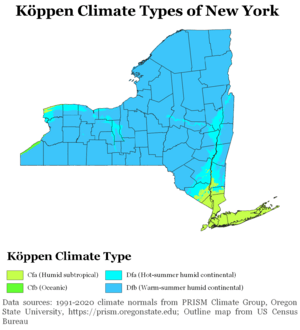
Most of New York has a humid continental climate. This means it has warm summers and cold winters. However, New York City and Long Island have a humid subtropical climate, which is milder. New York's weather is greatly affected by two large air masses. One is warm and humid from the southwest. The other is cold and dry from the northwest.
Downstate New York (New York City, Long Island, and the lower Hudson Valley) has hot summers. These summers can have periods of high humidity. Winters are cold and damp but are milder than in Upstate New York. This is because Downstate is at a lower elevation, closer to the Atlantic Ocean, and has a lower latitude.
Upstate New York has warm summers, with only occasional short periods of humid conditions. Winters are long and cold. Western New York, especially the Tug Hill region, gets heavy lake-effect snow. This happens when cold air moves over warmer lake waters. This is especially true in early winter before Lake Ontario freezes over. The summer climate is cool in the Adirondacks, Catskills, and higher parts of the Southern Tier. Buffalo and its area are seen as good places for climate change because of their weather patterns.
Summer daytime temperatures are usually in the high 70s to low 80s°F (25 to 28°C) across most of the state. In most winters, temperatures of -13°F (-25°C) or lower can be expected in the northern highlands. Temperatures of 5°F (-15°C) or colder can be expected in the southwestern and east-central highlands of the Southern Tier. New York's highest recorded temperature was 108°F (42.2°C) on July 22, 1926, in the Albany area. Its lowest recorded temperature was -52°F (-46.7°C) in 1979. Governors Island, Manhattan, in New York Harbor, is planned to have a $1 billion research center. This center aims to make New York a global leader in dealing with the climate crisis.
Plants and Animals in New York
New York has a relatively large land area and unique geography. This means it has several different ecoregions (areas with similar ecosystems). Many of these have been greatly reduced by cities and human activities. These include:
- Southern Great Lakes forests in Western New York.
- New England–Acadian forests near the New England border.
- Northeastern coastal forests in the lower Hudson Valley and western Long Island.
- Atlantic coastal pine barrens in southern Long Island.
- Northeastern interior dry–mesic oak forest in the eastern Southern Tier and upper Hudson Valley.
- Appalachian–Blue Ridge forests in the Hudson Valley.
- Central Appalachian dry oak–pine forest around the Hudson Valley.
- Eastern Great Lakes and Hudson Lowlands.
- Eastern forest–boreal transition in the Adirondacks.
- Eastern Great Lakes lowland forests around the Adirondacks.
- Allegheny Highlands forests, mostly in the western Southern Tier.
Some plant species found in New York are American ginseng, starry stonewort, waterthyme, water chestnut, eastern poison ivy, poison sumac, giant hogweed, cow parsnip, and common nettle.
There are more than 70 mammal species and over 20 bird species. There are also several types of amphibians and reptiles.
- Mammals include the white-footed mouse, North American least shrew, little brown bat, muskrat, eastern gray squirrel, eastern cottontail, American ermine, groundhog, striped skunk, fisher, North American river otter, raccoon, bobcat, eastern coyote, red fox, gray fox, white-tailed deer, moose, and American black bear.
- Mammals that used to live here but are now gone (extirpated) include the Canada lynx, American bison, wolverine, Allegheny woodrat, caribou, eastern elk, eastern cougar, and eastern wolf.
- Birds include the ring-necked pheasant, northern bobwhite, ruffed grouse, spruce grouse, Canada jay, wild turkey, blue jay, eastern bluebird (the state bird), American robin, and black-capped chickadee.
- Birds of prey include great horned owls, bald eagles, red-tailed hawks, American kestrels, and northern harriers.
- Waterfowl like mallards, wood ducks, canvasbacks, American black ducks, trumpeter swans, Canada geese, and blue-winged teals can be found.
- Shore birds include great blue heron, killdeers, northern cardinals, American herring gulls, and common terns.
- Reptile and amphibian species on land include queen snakes, hellbenders, diamondback terrapins, timber rattlesnakes, eastern fence lizards, spotted turtles, and Blanding's turtles.
- Sea turtles found in the state are the green sea turtle, loggerhead sea turtle, leatherback sea turtle, and Kemp's ridley sea turtle.
- New York Harbor and the Hudson River form an estuary (where fresh and salt water mix). This makes New York home to many marine animals. These include shellfish like oysters and clams, as well as fish, tiny organisms, and sea-birds.
Regions of New York
New York has a long history, so it has many different ways of defining its regions. These regions often overlap and can be confusing. The New York State Department of Economic Development has two main ways of defining these regions.
It divides the state into ten economic regions. These generally match the names people use:
- Western New York
- Finger Lakes
- Southern Tier
- Central New York
- North Country
- Mohawk Valley
- Capital District
- Hudson Valley
- New York City
- Long Island
The department also groups counties into eleven regions for tourism:
- Chautauqua–Allegheny
- Niagara Frontier
- Finger Lakes
- Thousand Islands
- Central-Leatherstocking Region
- Adirondack Mountains
- Capital District
- Catskill Mountains
- Hudson Valley
- New York City
- Long Island
State Parks and Preserves
New York has many state parks and two large forest preserves. Niagara Falls State Park, created in 1885, is the oldest state park in the United States. It was the first to be created by the government taking private land for public use (eminent domain). In 1892, Adirondack Park was established. It's about the size of Vermont and is the largest state park in the U.S. In 1894, it was given state constitutional protection to remain "forever wild." This park is larger than Yellowstone, Everglades, Glacier, and Grand Canyon national parks combined. The Catskill Park was protected by law in 1885. This law said its land must be kept safe and never sold or leased. This park is 700,000 acres (2,800 square kilometers) and is home to deer, minks, and fishers. About 400 black bears live there. The state runs many campgrounds, and there are over 300 miles (480 kilometers) of trails in the park.
The 1797 Montauk Lighthouse was ordered by President George Washington. It is a popular tourist spot in Montauk Point State Park at the eastern tip of Long Island. Hither Hills State Park, also on Long Island's South Fork, offers camping. It's a favorite place for sport fishermen who fish from the shore.
National Parks and Landmarks
New York State has many sites in the National Park System. There are 22 national parks, which had over 16 million visitors in 2011. There are also four national heritage areas, 27 national natural landmarks, 262 national historic landmarks, and 5,379 places listed on the National Register of Historic Places. Here are some important ones:
- The Statue of Liberty National Monument includes Ellis Island and the Statue of Liberty. The statue, designed by Frédéric Bartholdi, was a gift from France to the United States. It celebrated 100 years of the American Declaration of Independence. It was dedicated in New York Harbor on October 28, 1886. It has become a symbol of the United States and of democracy and freedom.
- The African Burial Ground National Monument in Lower Manhattan is the only national monument for Americans of African heritage. It protects a site with the remains of over 400 Africans. They were buried there in the late 1600s and 1700s. This was part of the largest colonial-era cemetery for people of African descent, both free and enslaved. It's believed tens of thousands of remains are buried there. The digging and study of the site were called "the most important historic urban archeological project in the United States."
- Fire Island National Seashore protects a 26-mile (42-kilometer) part of Fire Island. This is a barrier island about 30 miles (48 kilometers) long. It is separated from Long Island by the Great South Bay. The island is part of Suffolk County.
- Gateway National Recreation Area is over 26,000 acres (105 square kilometers) of water, salt marsh, wetlands, islands, and shoreline. It is at the entrance to New York Harbor, mostly within New York. It covers more area than two Manhattan islands.
- General Grant National Memorial is where President Ulysses S. Grant is buried. It is the largest mausoleum (a large tomb) in North America.
- Hamilton Grange National Memorial protects the home of Alexander Hamilton. He was an immigrant and orphan from the Caribbean who became a founding father of the United States and worked closely with George Washington.
- The Home of Franklin D. Roosevelt National Historic Site, created in 1945, protects the Springwood estate in Hyde Park, New York. Springwood was where the 32nd President of the United States, Franklin D. Roosevelt, was born, lived his whole life, and was buried.
- Niagara Falls National Heritage Area was named by the U.S. Congress in 2008. It goes from the western border of Wheatfield, New York to the mouth of the Niagara River on Lake Ontario. It includes Niagara Falls, Youngstown, and Lewiston. It also includes Niagara Falls State Park and Colonial Niagara Historic District. It is managed with the state.
- Saratoga National Historical Park protects the site of the Battles of Saratoga. This was the first important American military victory of the American Revolutionary War. In 1777, American forces defeated a large British Army. This led France to recognize the United States' independence and join the war as a key ally.
- Stonewall National Monument, in the Greenwich Village neighborhood of Lower Manhattan, is the first U.S. national monument for LGBTQ rights. It was named on June 24, 2016. The monument includes the area around the Stonewall Inn, which is still privately run. This place is known as the start of the gay liberation movement because of the 1969 Stonewall Riots. It also includes the nearby Christopher Park and surrounding streets.
- Manhattan's Theodore Roosevelt Birthplace National Historic Site is also the childhood home of President Theodore Roosevelt. He was the only president born in New York City until Donald Trump.
Cities and Towns in New York
As of 2022, New York is divided into 62 counties. Outside of New York City's five counties, each county is split into towns and cities. These are officially recognized by state law. Towns can have incorporated villages or unincorporated hamlets. New York City is divided into five boroughs, and each borough is also a county. The state's major cities grew along the main transportation and trade routes of the early 1800s. These included the Erie Canal and the railroads built next to it. The New York Thruway is like a modern version of these old trade routes. Downstate New York (New York City, Long Island, and the southern part of the Hudson Valley) is the main part of the Northeast megalopolis. This is a large urban area stretching from New Hampshire to Virginia.
New York has 62 official cities. The largest city in the state, and the most populated city in the United States, is New York City. It includes five counties (each also a borough): Bronx, New York County (Manhattan), Queens, Kings County (Brooklyn), and Richmond County (Staten Island). More than two-fifths of the state's population lives in New York City. Albany, the state capital, is the sixth-largest city in New York State. The smallest city is Sherrill, New York, in Oneida County. Hempstead is the most populated town in the state. If it were a city, it would be the second-largest in New York, with over 700,000 people. New York has 13 metropolitan areas, as defined by the U.S. Census Bureau. Major metro areas include New York City, Buffalo, Rochester, the Capital District (Albany, Schenectady, and Troy), Poughkeepsie, Syracuse, Utica, and Binghamton.
People of New York
Population Trends
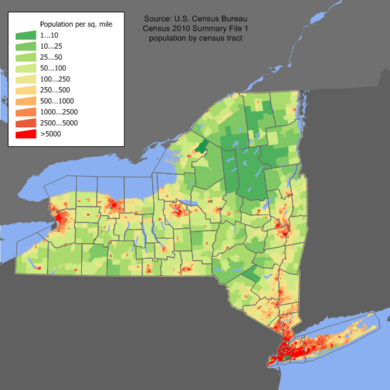
New York was the most populated state in the U.S. from the 1810s until 1962. As of 2024, it is the nation's fourth-most populated state. It is behind California, Texas, and Florida. Population growth has not been even across the state. The New York metropolitan area, Buffalo–Niagara Falls metropolitan area, Saratoga County, and Capital District are growing. However, Rochester, Syracuse, and other population centers have been losing people or staying the same for decades. New York City gained 223,615 residents between April 2010 and July 2018. This was the biggest population increase of any U.S. city. After 2020, its population slightly went down.
New York is a top place for people moving from other countries. In 2008, New York had the second-largest number of international immigrants in the country, with 4.2 million. Most of them live in and around New York City. This is because of its size, fame, strong economy, and diverse culture. New York has a law that supports sanctuary cities.
The United States Census Bureau counted New York's population as 20,215,751 on April 1, 2020. This was a 4.3% increase since the 2010 census. Even though there is a lot of open land in the state, most of New York's population lives in cities. About 92% of residents live in urban areas, mostly in the New York City metropolitan area.
Two-thirds of the state's population lives in the New York metropolitan area. New York City is the most populated city in the United States. In 2017, its population was estimated to be a record high of 8,622,698. This was due to more people moving into the city than leaving since the 2010 census. More than twice as many people live in New York City as in Los Angeles, the second-most populated U.S. city, and in a smaller area. Long Island alone had an estimated 7,838,722 residents in 2015. This was 39.6% of New York State's population. Of the total state population, 6.5% of New Yorkers were under five years old, 24.7% were under 18, and 12.9% were 65 or older.
In 2022, a report by HUD estimated that there were 74,178 homeless people in New York.
In 2017, the most common birthplaces for people in New York who were born outside the state were the Dominican Republic, China, India, Puerto Rico, New Jersey, Pennsylvania, Russia, Mexico, and Central American countries.
Diversity and Ethnic Groups
According to the 2000 census, the most common family backgrounds were Italian, Irish, German, African American, and English.
The state's largest racial group, non-Hispanic White people, became a smaller part of the population. In 1940, they were 94.6% of the state. By 2010, they were 58.3%. As of 2011, 55.6% of New York's population under age 1 were minorities. New York has a fast-growing Jewish population. In 2012, it was the largest outside of Israel, both by percentage and total number. This growth is mainly due to the high birth rate of Orthodox Jewish families, especially in Brooklyn and parts of the Hudson Valley.
New York has the second-largest Asian American population and the fourth-largest Black or African American population in the United States. New York's Black and African population grew by 2.0% between 2000 and 2010, reaching 3,073,800. In 2019, it grew to an estimated 3,424,002. The Black or African American population is changing. New York is the biggest receiver of immigrants from Africa. At the same time, some established Black and African Americans are moving out of New York to the southern United States. The Harlem neighborhood in New York City has historically been a major cultural center for Black and African Americans from sub-Saharan Africa. Bedford-Stuyvesant in Brooklyn has the largest such population in the United States.
Meanwhile, New York's Asian population grew by a significant 36% from 2000 to 2010, reaching 1,420,244. In 2019, its population grew to an estimated 1,579,494. Queens, in New York City, has the state's largest Asian American population. It is the most ethnically diverse county in the United States and the most ethnically diverse urban area in the world.
New York's growing Hispanic and Latino American population was 3,416,922 in 2010. This was a 19% increase from 2,867,583 in 2000. In 2020, it was estimated to be 3,811,000. Queens has the largest Andean (Colombian, Ecuadorian, Peruvian, and Bolivian) populations in the United States. New York also has the largest Puerto Rican, Dominican, and Jamaican American populations in the continental United States. The Chinese population is the fastest-growing group in New York State. It is the top place for new Chinese immigrants, and many Chinese people continue to move to the state. Several smaller Chinese communities have grown from the original Manhattan Chinatown. These include areas in Brooklyn and around Flushing, Queens. They are growing as traditional urban neighborhoods and also spreading quickly eastward into suburban Nassau County, on Long Island. Long Island, including Queens and Nassau County, also has several Little Indias and a large Koreatown. These areas have large and growing populations of Indian Americans and Korean Americans. Brooklyn has been a place for West Indian immigrants of African descent, as well as Asian Indian immigrants. The yearly New York City India Day Parade, held around August 15 since 1981, is the world's largest Indian Independence Day parade outside of India.
In the 2000 U.S. census, New York had the largest Italian American population. This group was the largest self-identified ancestry in Staten Island and Long Island, followed by Irish Americans. Albany and the Mohawk Valley also have large communities of Italian and Irish Americans. This shows the immigration patterns of the 1800s and early 1900s. According to the 2011-2015 American Community Survey, New York also had the largest Greek American population, with 148,637 people (0.7% of the state). In Buffalo and Western New York, German Americans are the largest ancestry group. In the North Country of New York, French Canadians are the main ethnic group, because the area is close to Quebec. Americans of English ancestry are found throughout upstate New York. This reflects early colonial settlers and later immigrants.
Languages Spoken in New York
In 2019, the U.S. Census Bureau reported that 69.5% of New York's population aged 5 years and older spoke only English. About 30.6% spoke a language other than English. Spanish was still the second most spoken non-English language, with 2,758,925 speakers. Other Indo-European languages were spoken by 1,587,798 residents. Asian and Pacific Islander languages were spoken by 948,959 people.
In 2017, almost six million New York residents spoke a language other than English. About 1,249,541 New Yorkers spoke Spanish, 386,290 Chinese, 122,150 Russian, 63,615 Haitian Creole, 62,219 Bengali, and 60,405 Korean. In 2018, 12,756,975 people aged 5 years and older spoke English only. 10,415,395 people aged 18 and older spoke English only. Most Spanish-speaking households were not limited to English-speaking. An estimated 2.7 million households with residents aged 5 and older spoke Spanish. Chinese, Slavic, and French were the next largest household languages spoken in 2018.
In 2010, 70.72% (12,788,233) of New York residents aged five and older said they spoke only English at home. Meanwhile, 14.44% (2,611,903) spoke Spanish. 2.61% (472,955) spoke Chinese (including Cantonese and Mandarin). 1.20% (216,468) spoke Russian. 1.18% (213,785) spoke Italian. 0.79% (142,169) spoke French Creole. 0.75% (135,789) spoke French. 0.67% (121,917) spoke Yiddish. 0.63% (114,574) spoke Korean. And Polish was spoken by 0.53% (95,413) of the population over the age of five. In total, 29.28% (5,295,016) of New York's population aged five and older reported speaking a language other than English.
In 2010, the most common American English dialects spoken in New York, besides General American English, were the New York City area dialect (including New York Latino English and North Jersey English), the Western New England accent around Albany, and Inland Northern American English in Buffalo and western New York State. As many as 800 languages are spoken in New York City. This makes it the most linguistically diverse city in the world.
Religions in New York
In 2014, the Pew Research Center studied New York's religious population. They found that most people, 60%, are Christian. After Christians, the next largest groups are those with no religion (27%), Judaism (7%), Islam (2%), Buddhism and Hinduism (1% each), and other faiths (0.5%). Another study by the Public Religion Research Institute in 2020 showed that 67% of New York's religious or spiritual population were Christian. This was followed by those with no religion (22%), Judaism (4%), Islam (2%), Buddhism and Hinduism (1% each), and other faiths (1%).
Before the 1800s, Protestant groups were the main religions in New York. However, religion was not as big a part of public life in colonial New Netherland as it was in New England, which had many Puritans. Historically, New York was a place where new Christian denominations started during the Second Great Awakening. Non-Western Christian traditions and non-Christian religions did not grow much for a long time. This was because most immigrants came from Western Europe. The Immigration and Nationality Act of 1965 removed these limits, allowing other religious groups to grow.
The Roman Catholic Church is the largest Christian group in New York, according to the 2014 study (31%). The largest Roman Catholic area is the Latin Church's Archdiocese of York. The largest Eastern Catholic area is the Ruthenian Catholic Eparchy of Passaic of the Ruthenian Greek Catholic Church. The United Methodist Church was the largest Mainline Protestant group and the second largest overall. It was followed by the Episcopal Church in the U.S. and other Anglican groups. The Presbyterian Church (USA), Evangelical Lutheran Church in America, and American Baptist Churches USA were the next largest Mainline groups. Mainline Protestants made up 11% of Christians in the state in 2014. Among Evangelical Protestants, the Baptists, non-denominational Protestants, and Pentecostals were the largest groups. The National Baptist Convention (USA) and Progressive National Baptist Convention were the largest historically Black Protestant churches in New York. About 10% of Christians in New York identified as Evangelical Protestants in 2014. Also, the Eastern and Oriental Orthodox groups together made up 1% of the religious population. Jehovah's Witnesses and other Christians also made up 1%. In the 2020 study, Orthodox Christians made up 1% of the population, and Jehovah's Witnesses also grew to 1%.
According to the Pew Research Center, non-Christian religions make up 12% of New York state's population. Judaism is the second-largest religion, both in 2014 and 2020. In 2010, 588,500 people practiced Orthodox Judaism. A little over 392,953 people followed Islam. The Powers Street Mosque in New York City was the state's first Muslim organization. New York is also home to the oldest Zoroastrian fire temple in the nation. Less than 1% of New York's population practices New Age and contemporary paganism. Native American religions are also a small group. Across the state, 17% of people said they were not religious, 5% identified as agnostic (not sure if God exists), and 5% as atheist (do not believe in God).
Economy of New York
New York's total economic output (GDP) in 2022-Q2 was US$2.0 trillion. If New York State were its own country, it would have the 11th-largest economy in the world. However, in 2022, the New York City-centered metropolitan area (which includes parts of other states) produced over US$2.16 trillion. This is the largest metropolitan economy worldwide. It is only behind the total economic output (GDP) of nine nations.
Wall Street and Finance
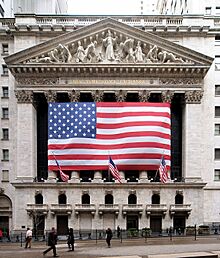
Wall Street in the Financial District of Lower Manhattan is the heart of New York City's economy. New York City has been called both the most economically powerful city and the leading financial center in the world. Lower Manhattan is the third-largest central business district in the United States. It is home to the New York Stock Exchange on Wall Street and Nasdaq at 165 Broadway. These are the world's largest and second-largest stock exchanges. They are measured by how much trading happens each day and by the total value of their listed companies in 2023.
New York City is still the biggest global center for trading in public equity (stocks) and debt capital markets (bonds). This is partly because of the size and financial development of the U.S. economy. New York also leads in private equity and the total money involved in mergers and acquisitions (when companies combine). Many financial companies and managers based in Manhattan are important players in other global financial centers. New York is also the main commercial banking center of the United States.
Many of the world's largest media conglomerates (big media companies) are also based in the city. Manhattan had about 520 million square feet (48.1 million square meters) of office space in 2013. This made it the largest office market in the United States. Midtown Manhattan is the largest central business district in the nation.
High Technology and Innovation
Silicon Alley and Long Island's Tech Growth
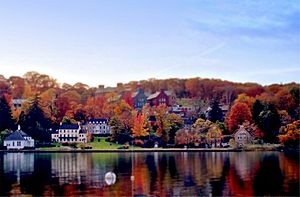
Silicon Alley, once just a small area in Manhattan, has grown to mean the whole New York City metropolitan area's high technology and business startup scene. In 2015, Silicon Alley attracted over $7.3 billion in venture capital (money invested in new businesses). High tech industries are growing. These include digital media, biotechnology, software development, game design, and other areas of information technology. This growth is helped by New York City's location at the end of several transatlantic fiber optic cables. It also has a lot of smart people and growing outdoor wireless internet.
In December 2014, New York State announced a $50 million venture-capital fund. This fund was to encourage businesses working in biotechnology and advanced materials. Former Governor Andrew Cuomo said this money would help entrepreneurs (people who start businesses) bring their research to the market.
On December 19, 2011, then-Mayor Michael R. Bloomberg announced that Cornell University and Technion-Israel Institute of Technology would build a two-billion-dollar graduate school for applied sciences on Roosevelt Island in Manhattan. The goal was to make New York City the world's top technology capital.
New York City's artificial intelligence (AI) sector alone raised US$483.6 million in venture capital in 2022. In 2023, New York introduced the first plan to create rules and a chatbot to control how AI is used within the city government.
Long Island is a key area for STEM (Science, Technology, Engineering, and Math) education and technology. Biotechnology companies and scientific research are very important to Long Island's economy. This includes research facilities at Brookhaven National Laboratory, Cold Spring Harbor Laboratory, Stony Brook University, New York Institute of Technology, Plum Island Animal Disease Center, the New York University Tandon School of Engineering, the City University of New York, the Hofstra Northwell School of Medicine, and the Feinstein Institutes for Medical Research.
Tech Valley's Growth
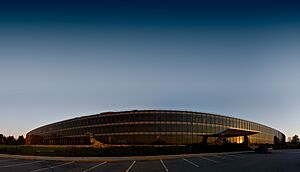

Albany, Saratoga County, Rensselaer County, and the Hudson Valley are known as eastern New York's Tech Valley. This area has seen a lot of growth in the computer hardware industry. It has made big progress in nanotechnology, digital electronics design, and making integrated microchip circuits (which need a lot of water and electricity). Companies like IBM and its Thomas J. Watson Research Center, along with foreign firms like GlobalFoundries, Samsung, and Taiwan Semiconductor, are involved. The area's high-tech environment is supported by tech-focused schools like Rensselaer Polytechnic Institute and the SUNY Polytechnic Institute.
In 2015, Tech Valley, located along the Adirondack Northway and the New York Thruway, received over $163 million in venture capital investment. The Rochester area is important for photographic processing and imaging. It is also growing as a high-tech area, including STEM fields. This is partly due to new startup businesses working with major schools like the University of Rochester and Cornell University.
Westchester County has developed a growing biotechnology sector in the 21st century. As of 2016, over a billion dollars in private money was planned for investment there. In April 2021, GlobalFoundries, a company that makes semiconductor chips, moved its headquarters from Silicon Valley, California to its most advanced chip-making facility in Saratoga County. This is near a part of the Adirondack Northway, in Malta, New York.
Media and Entertainment
Creative industries are those that create and share knowledge and information. These include new media, digital media, film and television production, advertising, fashion, design, and architecture. These industries make up a growing part of jobs, and New York City has a strong advantage in them. As of 2014, New York State offered tax breaks of up to $420 million each year for filmmaking within the state. This was the most generous tax rebate among U.S. states. New York has also attracted higher-paying visual-effects jobs. It did this by increasing its tax credit to a maximum of 35% for doing post-film production work in Upstate New York. The filmed entertainment industry has been growing in New York. As of 2015, it added nearly $9 billion to the New York City economy alone.
Tourism in New York
The phrase "I Love New York" (written as I ❤ NY) is a slogan, a logo, and a state song. It has been used since 1977 in an advertising campaign to promote tourism in New York state, including New York City. The trademarked logo is owned by New York State Empire State Development. The Broadway League reported that Broadway shows sold about $1.27 billion worth of tickets in the 2013–2014 season. This was an 11.4% increase from $1.139 billion in the 2012–2013 season. Attendance in 2013–2014 was 12.21 million people, a 5.5% increase from the 11.57 million in the 2012–2013 season.
Exports and Agriculture
New York exports many different goods. These include prepared foods, computers and electronics, cut diamonds, and other products. In 2007, the state exported $71.1 billion worth of goods. The top five foreign markets were Canada ($15 billion), the United Kingdom ($6 billion), Switzerland ($5.9 billion), Israel ($4.9 billion), and Hong Kong ($3.4 billion). New York's biggest imports are oil, gold, aluminum, natural gas, electricity, rough diamonds, and lumber. The state also has a large manufacturing sector. This includes printing and making garments (mostly in New York City), furs, railroad equipment, car parts, and bus vehicles (mostly in Upstate regions).
New York is the nation's third-largest grape producing state. It is also the third-largest wine producer by volume, after California and Washington. The southern Finger Lakes hillsides, the Hudson Valley, the North Fork of Long Island, and the southern shore of Lake Erie are the main grape and wine-growing areas in New York. There are many vineyards there. In 2012, New York had 320 wineries and 37,000 acres (15,000 hectares) of grape-bearing land. This created full-time jobs for almost 25,000 people and annual wages over $1.1 billion. It also brought in $4.8 billion in direct economic impact from New York grapes, grape juice, and wine products.
The New York agriculture industry is a big producer overall. It ranks among the top five states for farm products like maple syrup, apples, cherries, cabbage, dairy products, onions, and potatoes. The state is the largest producer of cabbage in the U.S. About a quarter of the state's land is used for farms. In 2001, these farms produced $3.4 billion in agricultural products. The south shore of Lake Ontario has the right soil and weather for many apple, cherry, plum, pear, and peach orchards. Apples are also grown in the Hudson Valley and near Lake Champlain. A moderately sized saltwater fishing industry is located along the Atlantic side of Long Island. The most valuable catches are clams, lobsters, squid, and flounder.
Education in New York

Among all colleges and universities in New York, Cornell University in Ithaca and Columbia University in Upper Manhattan are the most selective. Both are Ivy League universities and are famous private universities worldwide. New York University in Manhattan also ranks highly among New York state universities. Other notable large private universities include Syracuse University and Fordham University. Smaller private schools for higher education include University of Rochester, Rockefeller University, Mercy University, New York Institute of Technology, Rensselaer Polytechnic Institute, Yeshiva University, and Hofstra University. There are also many schools for postgraduate studies in New York State. These include medical, law, and engineering schools like New York Medical College and New York Law School.
The United States Military Academy at West Point is the U.S. Army's service academy. It is located just south of Newburgh, on the west bank of the Hudson River. The federal Merchant Marine Academy is at Kings Point on Long Island.
For post-secondary education, the statewide public university system is the State University of New York (SUNY). The SUNY system has 64 community colleges, technical colleges, undergraduate colleges, and institutions that grant doctoral degrees. The SUNY system has four "university centers": Albany (1844), Buffalo (1846), Binghamton (1946), and Stony Brook (1957). Buffalo and Stony Brook are the two main universities. The SUNY system has three academic medical centers: Renaissance School of Medicine at Stony Brook University on Long Island, Norton College of Medicine at SUNY Upstate Medical University in Syracuse, and SUNY Downstate Medical Center in Brooklyn.
The City University of New York (CUNY) is the public university system for New York City. It is the largest urban university system in the United States. It has 25 campuses: eleven senior colleges, seven community colleges, and seven professional institutions. While its colleges started as early as 1847, CUNY was officially created in 1961. The university has more than 275,000 students. Its alumni include thirteen Nobel Prize winners and twenty-four MacArthur Fellows.
A number of selective private liberal arts colleges are in New York. These include Adelphi University, Bard College, Barnard College, Colgate University, Hamilton College, Hobart and William Smith Colleges, Marist College, Sarah Lawrence College, Skidmore College, St. Lawrence University, Union College, and Vassar College. Two of these schools, Barnard and Vassar, are part of the selective Seven Sisters. These were originally all-women's colleges with ties to the Ivy League. Barnard is connected with Columbia University, its neighbor in Manhattan. Vassar became coeducational in 1969 after turning down an offer to merge with Yale University.
New York is also home to what are considered some of the best performing arts schools in the world. The Juilliard School, located in the Upper West Side of Manhattan, is a leading music and dance school. The Eastman School of Music, a professional school within the University of Rochester, was ranked first among U.S. music schools by U.S. News & World Report for five years in a row.
The University of the State of New York approves and sets rules for elementary, middle, and high school education in the state. The New York State Education Department oversees public schools and controls their standardized tests. The New York City Department of Education manages the New York City Public Schools system. In 1894, reflecting the racial discrimination of the time, the state passed a law that allowed communities to set up separate schools for African-American children. In 1900, the state passed another law requiring schools to be integrated. During the 2013 fiscal year, New York spent more money per student on public education than any other state, according to U.S. Census Bureau statistics.
Transportation in New York

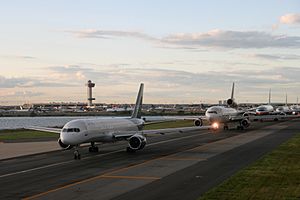
New York has one of the oldest and most extensive transportation systems in the country. Engineers have always had to find ways to overcome challenges. These include the state's complex landscape and the unique problems of crowded New York City. The state's population grew along its early waterways, first the Hudson River and Mohawk River, then the Erie Canal. In the 1800s, railroads were built along the river valleys. In the 1900s, the New York State Thruway was built.
Roads and Highways
The New York State Department of Transportation (NYSDOT) is the part of the New York government that plans and runs highways, railroads, mass transit systems, ports, waterways, and airports in New York State. The NYSDOT's main office is at 50 Wolf Road in Colonie, Albany County. The Port Authority of New York and New Jersey (PANYNJ) is a joint project between New York and New Jersey. It was approved by the U.S. Congress and started in 1921. It manages much of the region's transportation, including bridges, tunnels, airports, and seaports. This 1,500 square mile (3,900 square kilometer) port area is generally within a 25-mile (40-kilometer) radius of the Statue of Liberty National Monument. The Port Authority's main office is at 4 World Trade Center in Lower Manhattan.
The New York State Department of Motor Vehicles (NYSDMV or DMV) is the government agency that registers and inspects cars and other motor vehicles. It also gives out driver's licenses in New York State. As of 2008, the NYSDMV had 11,284,546 driver's licenses and 10,697,644 vehicle registrations. All gasoline-powered vehicles registered in New York State must have an emissions inspection every 12 months. This makes sure that environmental quality controls are working to prevent air pollution. Diesel-powered vehicles weighing over 8,500 pounds (3,856 kg) that are registered in most Downstate New York counties must get an annual emissions inspection. All vehicles registered in New York State must get an annual safety inspection.
Public Transportation
Besides the New York City Subway system, which is only in New York City's five boroughs, New York state has four suburban commuter railroad systems that go into and out of the city. These are the Long Island Rail Road, Metro-North Railroad, Port Authority Trans-Hudson, and five of New Jersey Transit's rail lines. The New York City Department of Transportation (NYCDOT) is the agency of the New York City government that manages much of New York City's own transportation. In Buffalo, the Niagara Frontier Transportation Authority runs the Buffalo Metro Rail light-rail system. In Rochester, the Rochester Subway operated from 1927 until 1956. It stopped being used as state and federal money went to highways instead.
Airports
Parts of the transportation system are intermodal. This means travelers can easily switch from one type of transportation to another. One good example is AirTrain JFK. This allows train passengers to travel directly to terminals at John F. Kennedy International Airport and to the underground New York City Subway system.
Sports in New York
New York State is home to one National Football League team, the Buffalo Bills. They are based in the Buffalo suburb of Orchard Park. Even though the New York Giants and New York Jets represent the New York City metropolitan area and used to be in New York City, they now play in MetLife Stadium, which is in East Rutherford, New Jersey. New York also has two Major League Baseball teams: the New York Yankees (in the Bronx) and the New York Mets (in Queens). Minor league baseball teams also play in New York State. These include the Long Island Ducks, the Staten Island FerryHawks, and the Brooklyn Cyclones downstate. Upstate, there are the Rochester Red Wings, the Binghamton Rumble Ponies, the Syracuse Mets, the Auburn Doubledays, the Batavia Muckdogs, the Hudson Valley Renegades, and the Buffalo Bisons.
New York is home to three National Hockey League teams: the New York Rangers in Manhattan, the New York Islanders in Nassau County on Long Island, and the Buffalo Sabres in Buffalo. New York has two National Basketball Association teams: the New York Knicks in Manhattan and the Brooklyn Nets in Brooklyn. It also has a Women's National Basketball Association team, the New York Liberty, also based in Brooklyn. New York is home to a Major League Soccer team, New York City FC. They currently play in the Bronx, but plan to build a new stadium in Queens. Although the New York Red Bulls represent the New York City metropolitan area, they play in Red Bull Arena in Harrison, New Jersey.
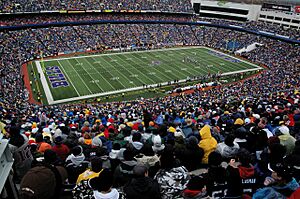
New York hosted the 1932 and 1980 Winter Olympics in Lake Placid. The 1980 Games are famous for the USA–USSR ice hockey game called the "Miracle on Ice." In this game, a group of American college students and amateurs beat the strong Soviet national ice hockey team 4–3. They then went on to win the gold medal against Finland. Along with St. Moritz, Switzerland and Innsbruck, Austria, Lake Placid is one of only three cities to have hosted the Winter Olympic Games twice. New York City bid to host the 2012 Summer Olympics but lost to London. The yearly United States Open Tennis Championships is one of the world's four major Grand Slam tennis tournaments. It is held at the National Tennis Center in Flushing Meadows–Corona Park in Queens. The Belmont Stakes, part of the Triple Crown of Thoroughbred Racing, is held at Belmont Park in Nassau County on Long Island.
Several U.S. national sports halls of fame are or have been in New York. The National Baseball Hall of Fame and Museum is in Cooperstown, Otsego County. The National Museum of Racing and Hall of Fame in Saratoga Springs, Saratoga County, honors achievements in thoroughbred horse racing. The building for the National Soccer Hall of Fame in Oneonta, also in Otsego County, closed in 2010. However, the organization still continues to induct people.
New York State is also home to many college sports programs in Division 1. The State University of New York's main campus at University at Buffalo has the Buffalo Bulls. Syracuse University's teams are the Syracuse Orange.
New York's strong sports background has also affected local industries like sports betting. Because of the many residents, tourists, and sports to bet on, New York became the first state to take in over $2 billion in sports bets in a single month.
Images for kids
See also
 In Spanish: Nueva York (estado) para niños
In Spanish: Nueva York (estado) para niños



